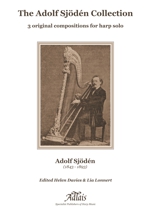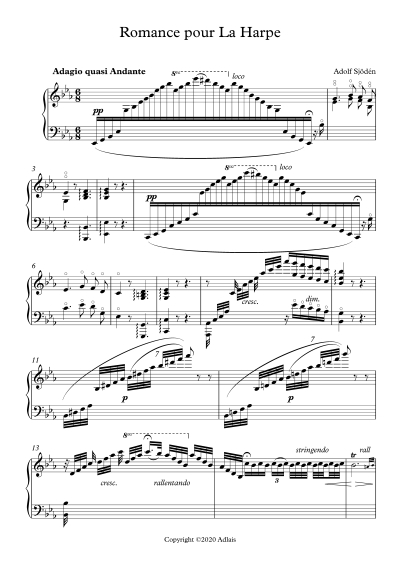 |
|||
| |
of Harp Music |
| © 2004-2025 ADLAIS |
| The Adolf Sjödén Collection Adolf Sjödén (1843 - 1893) Edited Helen Davies & Lia Lonnert |
return to previous page |
 |
Works: | 1. Romance pour La Harpe 2. Thema med Variationer för Harpa 3. Elegi (den 21 juli 1886) |
| Catalogue No: | Adlais 226 | |
| ISMN: | 979-0-57032-303-6 | |
| Edition: | June 2025 A4 stapled | |
| Suitable for: | Intermediate to advanced Pedal Harp | |
| Price:: | £10.00 Go to shop | |
3 original compositions for harp solo by Adolf Sjödén
Romance pour La Harpe
Sjödén gave this piece to a friend in the spring of 1865, just before he left Sweden to study in Vienna. It is possibly the piece called “Romance for the ladies” which he often played in his concerts.
Thema med Variationer för Harpa
This is a typically Viennese classical theme with different idiomatic variations which show the various characteristic scales, arpeggios and effects possible on the double action pedal harp.
Elegi (den 21 juli 1886)
Sjödén composed this slow and solemn piece for his mother’s funeral in 1886. There is a note on the manuscript in Sjödén’s hand dating the piece to 21st July 1886 and saying that he wrote it to play at his mother’s funeral. It seems that his sister Alma kept the manuscript as a precious memory.
ADOLF SJÖDÉN (1843-1893)
Born and brought up in Sollefteå in northern Sweden, Adolf Sjödén became one of the most famous travelling harp virtuosi of his time, acclaimed and feted wherever he played. He was also an avid collector of harp music and folk music and his large archive, held in Västernorrlands Museum, Sweden, bears witness to this.
There was much music making in Adolf’s home and his first harp teacher was the wife of a local clergyman. However his father decided on a career in medicine for him and he went to study in Stockholm. Whilst there he was able to continue to learn the harp, now with Anton Edouard Pratté (1796-1875), a Bohemian who had settled in Sweden.
In 1865 Sjödén moved to Vienna to continue his medical education, but he also continued to study the harp, this time with Antonio Zamara, (1823-1901), one of the most famous harpists and teachers of the time. Whilst in Vienna, Sjödén decided to focus entirely on a musical career and he made his concert debut in Austria at the age of 24.
Contemporary concert announcements show that he gave concerts in Austria, Italy, Germany, Switzerland, France, Portugal, Great Britain, Ireland, Sweden, Norway, Finland and Denmark. His sister Alma, a renowned singer, participated on at least one of his tours. He was appointed a court chamber musician to King Luiz of Portugal and received several other royal awards in Europe. Liszt transcribed one of his piano pieces - Ave Maria - for him, and Sjödén often included this piece in his concerts. He was friends with the Danish author Hans Christian Andersen and was a musical inspiration to the young Finnish Jean Sibelius.
Adolf Sjödén’s collection of music shows that he was a man of eclectic tastes and wide-ranging musical interest. The archive has many items of important historical and contemporary harp music, his own arrangements of older music, solo pieces written for him by composers he met, a large collection of unpublished music by his former teacher Pratté, and a huge number of folk tunes which he noted down on his travels. He arranged some of this folk music to play in his concerts, but he can also be said to be one of the pioneers in historically informed performance practice, with his interest in the harps and harp traditions of Wales and Ireland.
He met Lady Llanover – the great patroness of all things Welsh – in 1868/9. This meeting led to his interest in the Welsh triple harp and an invitation from Lady Llanover to perform Handel’s Harp Concerto in a concert at her London home in 1870. The Welsh musician Brinley Richards had rediscovered Handel’s “Concerto for the Welsh harp” in the British Museum and made a new edition of it. The concerto was part of a celebration of Welsh music on 15th July 1870 – an evening attended by royalty and the great and the good of London society. The high point of the evening was the performance of the Handel Concerto, and Sjödén learnt to play the Welsh triple harp for the occasion. Sources also indicate that he took this harp - as well as his Erard Gothic harp - on tour on numerous occasions.
Ten years later, in 1879, Sjödén was in Ireland, again showing his deep interest in native idioms and traditions. Here he organised a three day “Irish Harp Revival Festival” in May 1879 at the Rotunda concert rooms in Dublin. Emphasis was placed on Irish music and players on the old wire-strung harp were featured. This was a tradition that had almost died out at the time, but Sjödén recognised the importance of its continuation. He was also asked to lead the band of harps at the Thomas Moore bi-centenary celebrations and played Moore’s own harp at the event. Sjödén left a lasting legacy in Ireland in that he was friends with the antiquarian Sir Samuel Ferguson and his wife, and when presented with a beautiful air by Lady Ferguson he asked Sir Samuel to write words for it. The result was one of the most well known and well loved of Irish songs: “The Lark in the Clear Air”.
Sjödén was described as “tall, slight and graceful… with blond hair and soft blue eyes… The blonde signore who plays the harp like Sancta Cecilia”. Other contemporary sources speak of his kind and gentle personality, which is borne out by the fact that apart from his public concerts for aristocracy and royalty, he often gave charity and benefit concerts and reduced ticket prices for the less well off in society.
His health was not good and he spent time in warmer climes whenever possible. He lived in the spa town of Baden-Baden from 1877 and died in Biel in Switzerland at the age of 50.
Despite the size of his music archive, only three completed original pieces by Sjödén have been discovered so far. It is these pieces which are published here for the first time.
Sincere thanks to Västernorrlands Museum (Elegi) and The Music and Theatre Library of Sweden (Romance and Thema med Variationer). The Thema med Variationer is attributed to and signed by Adolf Sjödén, but there is also an unsigned copy amongst the Pratté papers.
This publication is dedicated to the memory of Ann Griffiths, who was the first to ask us the question: “Who was Adolf Sjödén?”
Copyright ©2022 Helen Davies & Lia Lonnert

The cover photo is reproduced by kind permission of Västernorrlands Museum, Sweden
The Erard ledgers show that Sjödén bought the harp pictured on the cover on 18th May 1877 from Maison Erard in Paris for the price of 8.000 francs. A contemporary review in a Swedish newspaper (Wermlands läns tidning) describes the harp: "This harp is a masterpiece, made in Paris and intended for an exhibition... The column of the harp consists of a work of art that depicts a palm tree rising from water. Two naiades protrude from the reeds at the foot of the column. At the top of the palm tree there is a crown surrounded by flower garlands where two turtle doves are perched. The front feet of the harp depict two dolphins emerging from the water and the hind feet are in the shape of two turtles. The harp is of course designed in accordance with the latest inventions and has, among other things, double action. The whole machinery, as well as the sculptural work, is heavily gilded.".
